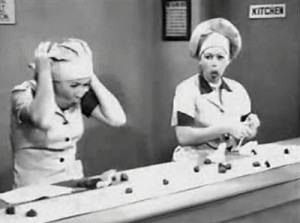 The previous article in this series about applying lean principles to improve personal work identified seven principal sources of muda (waste) that limit our ability to produce value-adding work. In this post we’ll look at some general principles and specific countermeasures to these.
The previous article in this series about applying lean principles to improve personal work identified seven principal sources of muda (waste) that limit our ability to produce value-adding work. In this post we’ll look at some general principles and specific countermeasures to these.
The list of ways to reduce waste is potentially limitless, and what works for one might not work for another. For that reason, we’ll keep this at a fairly high level, and only bring it down to specifics to illustrate each principle. The five principles that I’ve distilled from my reading and which I have found work well for me are:
In the first two articles of this series, we examined ways to make work easier using 5S and by making work visible. Later this week we will turn to a much harder topic: reducing waste. But before we do, it’s important to clarify two definitions.
The lean principles term for waste is muda, and it technically refers to any activity that does not add value to the end customer. So, to be precise with our terms, before we can identify waste we must first specify who is your customer(s) for your personal work, and what constitutes value to them.
Who is your customer for your personal work?
First, let’s define “customer” as anyone who depends on the output of your work.
The first customer is yourself. That sounds obvious on the surface, but some people need reminding of it. If you are a caregiver to an elderly parent for example, it’s all too easy to work yourself to exhaustion and ill health by focusing all our energy on him or her. You have to leave something for yourself.
At the same time, you also have an obligation to your future-self. While this is obvious, it helps you to define value and to distinguish between the urgent and the important, in Stephen Covey’s phrase. When you eat less today, or invest some of your income rather than spending it, you’re adding value to your future-self. Any time you devote efforts toward a long term goal, you are building value for your future-self. Keeping your future-self more prominent in your mind guides some of the choices you make today and improves impulse control. Think about it this way: You are now the future-self that “existed” years ago. How many times have you wished you had done more of something when you were younger? (I wish I had saved more money, or made more cold calls, paid more attention in class…)
Future focus is what allows you to make the hard choices to forgo short-term advantage for long term positioning. Robert Caro tells us how a young Texas congressman, who was so poor in 1940 that he had just recently been able to afford his first suit that fit, rejected a very lucrative offer of a partnership in the oil business from a wealthy benefactor. His decision wasn’t based on ethics (as proven by many other questionable deals he later became involved in), but on his future plans. He was concerned that being tied to oil money would hurt him politically. Since oil money was not a disadvantage in Texas, there was only one potential job where it would matter, and 32-year-old Lyndon Johnson gave up certain and immediate wealth for an extremely improbable dream.
Unless you live on an isolated island, there are probably others who depend on the output of your work. In my own case, I have decided to define three customers: myself, my family, and those who pay my bills (my clients). These are not totally separate—taking care of my clients boosts income which adds value to myself and my family; improving myself by learning helps my clients; becoming more efficient in my work makes me easier to live with and allows me to spend more time with my family, etc. This is important because greater alignment of interests and needs among all your customers is a wonderful source of synergy.
What is value to your “customer”?
Value will be highly personal. Donald Trump and Mother Teresa would probably define it differently. Some are driven by wealth, others by power, by artistic achievement, by religion, and so on. Only you can define it, but define it you must.
My personal definition of value is anything that makes me richer, smarter, healthier, or happier. (I see the latter two as being more related to personal life than work, so I will spare you the details in this and future articles.)
Fortunately, because I’ve chosen a career that allows me to monetize my passion for learning, the first two are very well aligned. It’s not always that way—sometimes your different definitions of value may conflict and you must make additional choices about priorities and balance.
By definition, then, muda in my personal work comprises any activity that does not make me richer or smarter. In the next article of this series, we will look at the most common sources of waste in personal work and countermeasures to reduce muda.

In the first article of this series on applying lean methods to personal work, I wrote about using 5S to clean and organize my workspace. In this article, I will explain my second step: making work visible. Experts in lean methods will probably quibble about the order in which I’m approaching this personal project, but I’m being driven by what I see as my most important priorities, and so far it’s working for me.
To understand why it’s so important to make your work visible, we must first look at some context. In his book A Factory of One: Applying Lean Principles to Banish Waste and Improve Your Personal Performance, Daniel Markovitz says that the core of lean is “the development of awareness and problem-solving skills, the capacity for self-correction, and total dedication to improvement.” The first step in that statement is the development of awareness, and you can’t be aware of what you can’t see.
How much of your pending tasks and work-in-process can you actually see? Unlike a factory worker who can see raw materials and half-completed assemblies, most knowledge workers can’t see everything that needs to be worked on. You may have piles of folders or loose papers, sticky notes all over your desk and walls, reminders in Outlook, etc. You may even have a detailed to-do list, but the longer it gets the more difficult it is to spot the priorities, or to distinguish the urgent from the important.
Even worse, people push more and more demands on you, and your work-in-process eventually gets to point where you feel like Lucy in the chocolate factory.
The solution is to develop a pull system, or personal kanban, as described in Personal Kanban: Mapping Work | Navigating Life by Jim Benson and Tonianne Barry. The book clearly shows you how and why to make your work visible. I’ll begin with the how, and that will better illustrate the why.
How to set up a personal kanban system
These are the steps outlined in PK.[1]
Get your stuff ready: the only ingredients needed for this are a whiteboard, markers, and sticky notes.
Establish your value stream: this one took me several iterations. I eventually divided my work into five value streams: customers (selling and delivering), writing, research and learning, special projects, and personal. Because I already have a sales funnel for my customers and prospects, that did not go on my board. I also kept my personal stuff separate on an existing board. Each of the three remaining value streams went on my board, divided into three principal phases: READY, WORK-IN-PROCESS (WIP), and DONE. As you will note, the WIP phase is further broken down depending on the type of work being done. (Ideally, the best way to establish your value stream is to first define your customer and what is value to your customer but I skipped that step for now.)
Establish your backlog: anyone familiar with David Allen’s Getting Things Done: The Art of Stress-Free Productivity will recognize this. As Allen says, “get it out of your head and onto paper.” The idea is that unfinished and unrecorded tasks stick around in our head as distractions and “existential overhead.” So, you begin by writing down everything you have to do on sticky notes. Get it all out of your head, no matter how long it takes or how discouraging it seems when you’ve done it. That pile becomes your backlog.
Establish your WIP limit: We pride ourselves on multi-tasking and being busy all the time, but most of us overestimate our ability to get things done. Benson and Barry clearly distinguish between capacity and throughput. Capacity is our theoretical output, based on our pace of work and the time we have available. Since we overestimate our pace and underestimate the time things will take, capacity will never equal throughput. Like a busy highway, pumping in more cars eventually results in gridlock. Everyone’s WIP limit will vary; their estimate is that a good measure of throughput is about 65% of capacity. This allows for the inevitable interruptions, crises, etc. that we omit from our plans.
Begin to pull: Once you have a comfortable amount of work on your board, pull a task out of READY when you have the capacity to do it. This is the stage where you use your judgment to prioritize. When the task is finished, move it to DONE. Ideally, you would work on one task at a time and see it through to completion. That’s not realistic, particularly when you’re dependent on inputs from others, so you can have several different things in WIP at one time.
Reflect: Take advantage of the visibility you get to periodically review your workflow and look for ways to improve it. The first thing that became obvious to me is that I begin too many books or articles at one time, which is one reason a lot of what I read is not absorbed and hence wasted. (Muda, or waste, is the subject of an upcoming article—which you may note from the board above.)
Why it works
Context: There is a certain energy and motivation you get when you can see why you are doing something and how it aligns with the big picture. Related to this is the concept of narrative. Just as information is more meaningful when it’s presented as part of a compelling story, making work visible lets you see the flow of work.
Clarity: Clarity motivates. As Chip and Dan Heath tell us in Switch, “…if you want people to change, you must provide crystal-clear direction.” They also go on to say, “Ambiguity is the enemy. Any successful change requires a translation of ambiguous goals into concrete behaviors. In short, to make a switch, you need to script the critical moves.” When you have a pile of unconnected tasks to do, the choices can be overwhelming and they can provide the environment and excuse for procrastination. Making your work visible reduces choices and lays out a clear path to unambiguous goals.
Closure: there’s something very satisfying about physically transferring a sticky note from one phase in the process to another, and to seeing them pile up in the DONE section.
As a side benefit, seeing the flow of work helps you identify activities that don’t add value. By definition, those are waste, which is the topic of the next article in this series.
[1] Note, just going through the 5S process goes a long way toward making work visible. There is a lot of unfinished work lurking in the piles of stuff on your desk and in your office.




